HIGHLIGHTS: May 10, 2024
• U.S. and Mexican dairy sectors reaffirm common goals
• USDEC launches new customer-facing U.S. cheese website
• Costa Rican regulators conduct U.S. dairy audit
• U.S. cheese shines at FHA Singapore
• LatAm cheese buyer’s mission to U.S.
• USAID allocates $200 million to RUTF procurement and distribution
• Progress on global plastics treaty
• Market Summary: GDT gains almost across the board
• USDEC testifies on trade agreements and supply chain resilience
• New Zealand launches trade talks with UAE; vows to continue fight against Canadian TRQs
• Mars dairy sustainability program
• Chinese dairy corporate results
• Company briefs: Dale Farm, Tirlán, Danone, FrieslandCampina
Featured
U.S. dairy reaffirms close relationship with Mexico at binational summit
Representatives from the U.S. and Mexican dairy industries recommitted to their long-standing partnership this week at the 6th Binational Dairy Summit in Chihuahua, Mexico. Both sides recommitted to cross-border cooperation in support of overall dairy sector growth for the benefit of producers, manufacturers and consumers in Mexico and the United States.
USDEC and NMPF steered the U.S. delegation, which included more than 14 USDEC member companies and U.S. farmer representatives. Five Mexican milk producer and dairy processor groups represented the Mexican side: Confederación Nacional de Organizaciones Ganaderas (CNOG), Asociación Mexicana de Productores de Leche (AMLAC), Consejo Nacional Bovino Leche (CNBL), Cámara Nacional de Industriales de la Leche (CANILEC), and Consejo Nacional Agropecuario (CNA).
The original partnership dates to 2005 but was reinvigorated in 2016 when USDEC and NMPF started a specific work program with the goal of building a stronger relationship in defense of open trade and science-based rules. The groups last met in Chicago in 2023 during the International Dairy Federation World Dairy Summit and before that in 2022 at Dairy Farmers of America headquarters in Kansas City. Both times they reaffirmed their commitment to work together to prevent trade barriers and expand consumption.
“Our industries share so many similar challenges that call for us to work together,” said USDEC President and CEO Krysta Harden, who led the USDEC delegation. “Mexico is and will continue to be a valuable partner for U.S. dairy. These meetings help strengthen those ties and set the dairy sectors in both countries up for continued success.”
This week’s summit yielded a list of 12 new and updated priorities ranging from preserving, facilitating and enhancing fair trade between the two nations to continuing activities in defense of common food names (particularly cheese names) to improving information sharing on topics ranging from sustainability to market trends. For the full list of 12 priorities, see this joint USDEC/NMPF new release statement on the summit.
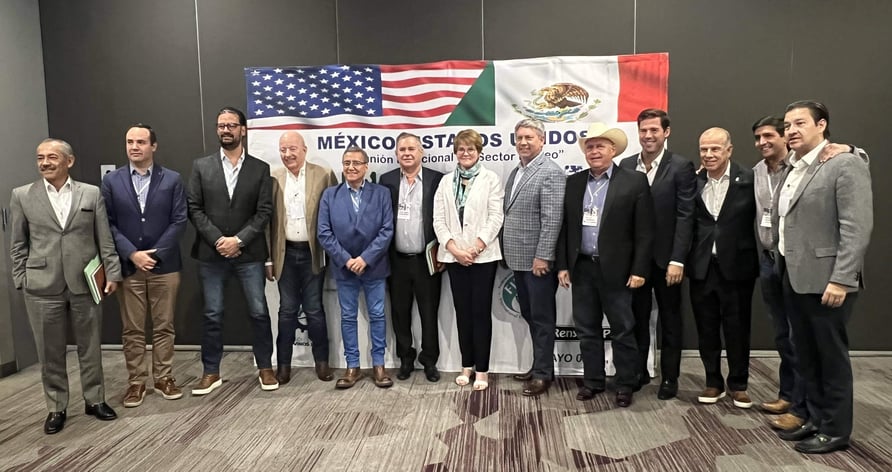
Leaders of the U.S. and Mexican dairy industries at this week’s binational summit.
USDEC launches new customer-facing USA cheese website
The new customer-facing Cheese from the USA website is up and running. The site, CheeseFromTheUSA.org, contains content on the U.S. dairy farming legacy, U.S. cheesemaking heritage, award-winning U.S. cheeses and U.S. cheese resources.
U.S. cheesemakers, with USDEC’s support, have come a long way over the last two decades in shifting perceptions of the United States as a reputable supplier of high-quality, award-winning cheese. This website is another step in showcasing the U.S. as an international center of cheesemaking excellence and innovation.
Visitors will have many options to click and learn more about U.S. cheese, including measures U.S. farmers and cheesemakers are taking to reduce their environmental footprint, the broad portfolio of U.S. products, interviews with U.S. cheesemakers, U.S. performance at international cheese awards, and USDEC’s library of useful USA cheese educational materials.
“The site highlights the stories we have to tell as an industry, from the farmers and cheesemakers to the cheeses themselves,” said Ryan Hopkin, USDEC director, cheese marketing communications.
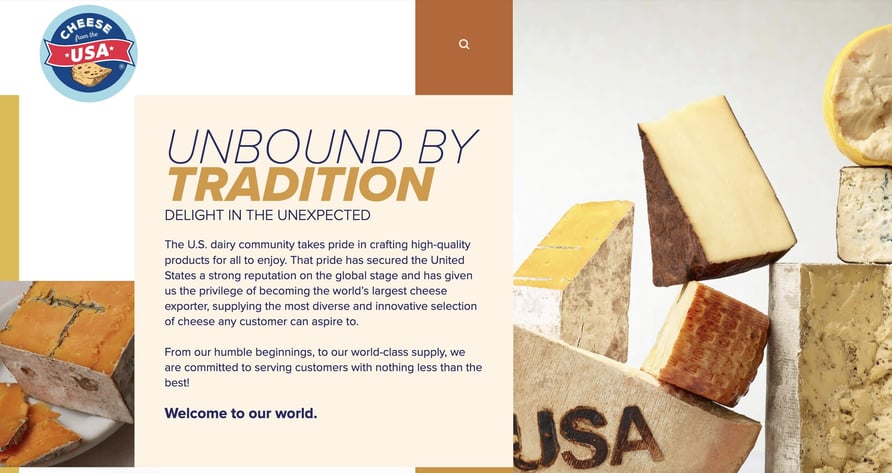
Costa Rican U.S. dairy audit could eliminate export questionnaire requirement
Officials from Costa Rica's National Animal Health Service (SENASA) were in Wisconsin this week visiting U.S. dairy facilities. SENASA is conducting a U.S. dairy regulatory system audit, which included visiting establishments currently exporting U.S. dairy products or intending to export to Costa Rica.
USDEC’s Market Access and Regulatory Affairs (MARA) team has been working with regulatory officials to facilitate the audit. The objective is to streamline the plant registration process for U.S. dairy facilities and eliminate the cumbersome and time-consuming questionnaire requirement. The visit was conducted in collaboration with the FDA, USDA and the Foreign Agricultural Service (FAS). USDEC’s Jonathan Gardener, senior vice president, MARA, and Oscar Ferrara, vice president, MARA, took part in the visit, accompanying Costa Rican officials during the week.
USDEC expects Costa Rica to deliver the results of the audit by the end of the year.
U.S. cheese shines at Food & Hotel Asia Singapore
U.S. cheese made a splash at this year’s Food & Hotel Asia (FHA) April 26-29 in Singapore. With an estimated 60,000 attendees and more than 1,500 exhibitors, FHA is one of Asia’s largest food and beverage expos. Nine member companies exhibited in the USA Dairy Pavilion.
USDEC’s goal there was threefold: 1) promote U.S. cheese excellence, 2) dispel misconceptions about U.S. cheese, and 3) foster connections with potential buyers across all channels (importers/distributors, retailers, regional manufacturers, foodservice companies, culinary institutions and influential regional chefs).
Several activities were organized in support of those goals.
USDEC engaged with a diverse audience at the booth, including U.S. Ambassador to Singapore Jonathan Kaplan; Regional Agricultural Counselor Timothy Harrison and Agricultural Attaché Karen Richards. USDEC also met with a series of key importers/distributors, including QB Food Trading from Singapore, Hightower Inc. from the Philippines, and PT Kairos Niaga Pratama from Indonesia, among others. Retailers included NTUC FairPrice Group, which operates a network of over 370 supermarket outlets. Foodservice companies and culinary institutions included Starbucks Philippines and the Singapore Hotel Association Training and Education Centre.
Discussions highlighted the diverse range of U.S. cheeses and provided insights into the U.S. cheese industry and the USA Cheese Guild’s initiatives in driving awareness of U.S. cheese in Southeast Asia.
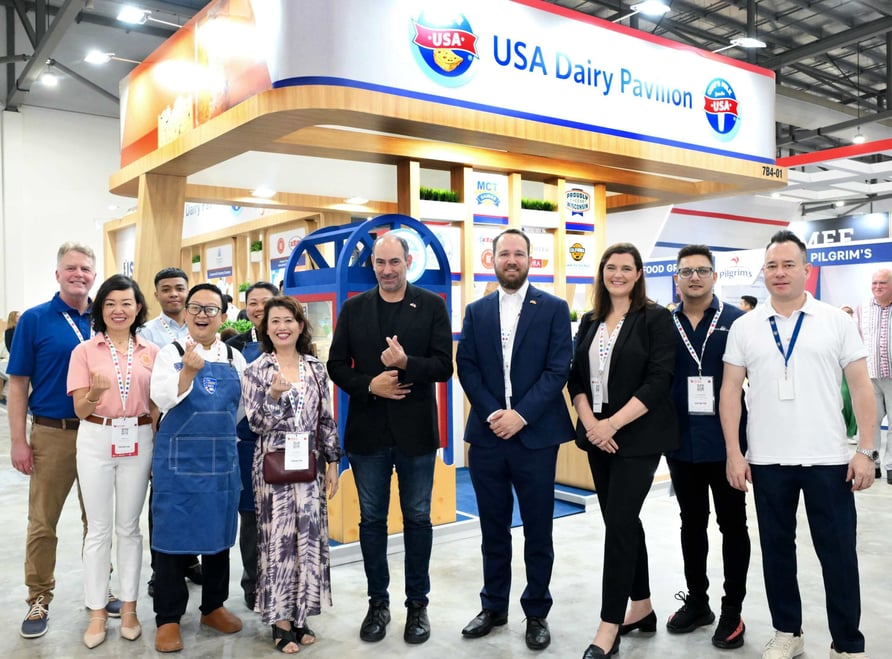
USDEC staff and U.S. member representatives pose with U.S. Ambassador to Singapore Jonathan Kaplan (fifth from right) at the USA Dairy Pavilion at FHA.

USDEC staff met with NTUC FairPrice Group representatives, including Chief Executive Vipul Chawla and President Tng Ah Yiam.
Twice-a-day culinary demonstrations led by USDEC consultant chef Muhammed Imran enticed crowds interested in sampling some of the innovative products that merge U.S. cheese with regional and local tastes. Chef Imran integrated U.S. mozzarella into ube pandesal (a Filipino bread roll), U.S. cream cheese into Chinese Peranakan crab rangoon pie tee, and U.S. truffle cheddar into Korean jeon potato pancakes.
USDEC hosted a “walking tour,” of the USA Dairy Pavilion for five local trade journalists so they could learn more about U.S. cheese. The journalists met with each USDEC member, hearing about their product lines, how they innovate and their sustainability practices. Chef Imran briefed the journalists on the versatility of U.S. cheeses in various culinary applications.
The media outreach sought to cultivate relationships with influential media members to bolster earned coverage and social media engagement. Two positive stories are already in the works, with the potential for more.
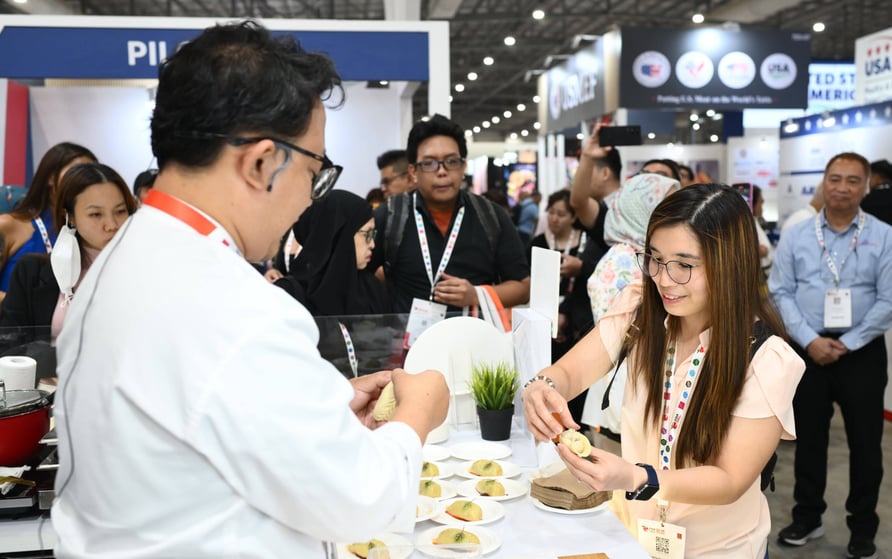
Chef Muhammed Imran involves FHA attendees in a cooking demo. The chef prepared Bergedil Culurgiones, a Malaysian-Italian fusion dumpling, made with U.S. Pepper Jack cheese for attendees to sample.
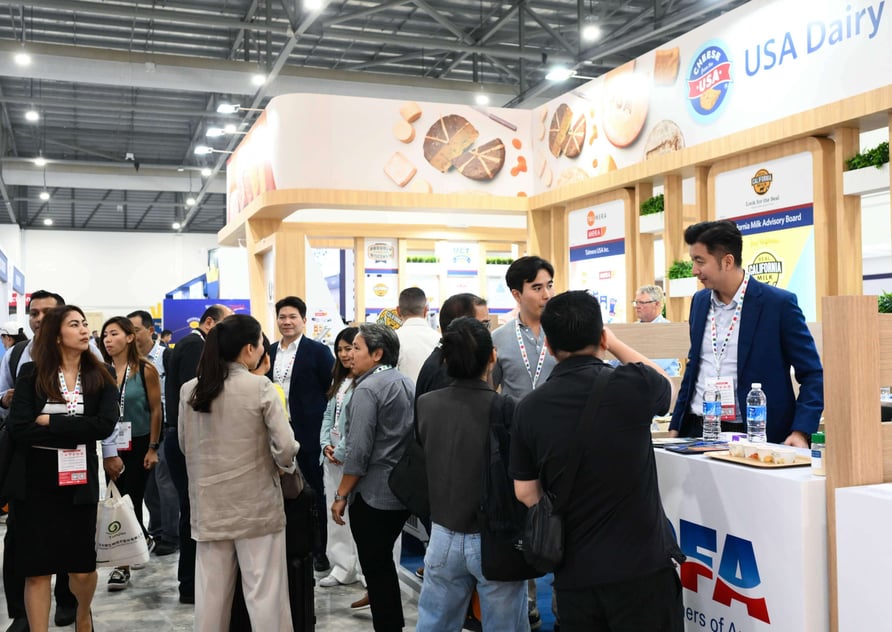
U.S. members participating at FHA saw high foot traffic throughout the exhibition.
U.S. suppliers engage with Latin American cheese buyers during USDEC-organized mission to the U.S.
USDEC hosted seven cheese buyers from Central and South America on a five-day LatAm Cheese Buyer’s Mission to the U.S. (April 15-19) to learn more about the U.S. cheese industry and facilitate business connections with U.S. suppliers. The USDEC Annual Membership Meeting in Houston was the centerpiece of the mission, providing several engagement opportunities with U.S. cheese suppliers, including scheduled one-on-one meetings on the meeting’s final day. Three of the buyers also participated in the panel discussion, “The LatAm Cheese Market: A Buyer’s Perspective,” in which they offered insights on their cheese needs and opportunities for U.S. suppliers.
USDEC also arranged retail tours to demonstrate the broad portfolio of U.S. cheese varieties and forms and a tour of a cheese production facility so they could experience first-hand the U.S. cheese industry's capabilities.
“The participating companies walked away with a greater understanding of and keen interest in sourcing from the U.S. cheese industry,” said Amy Foor, USDEC vice president, Global Foodservice Programs.
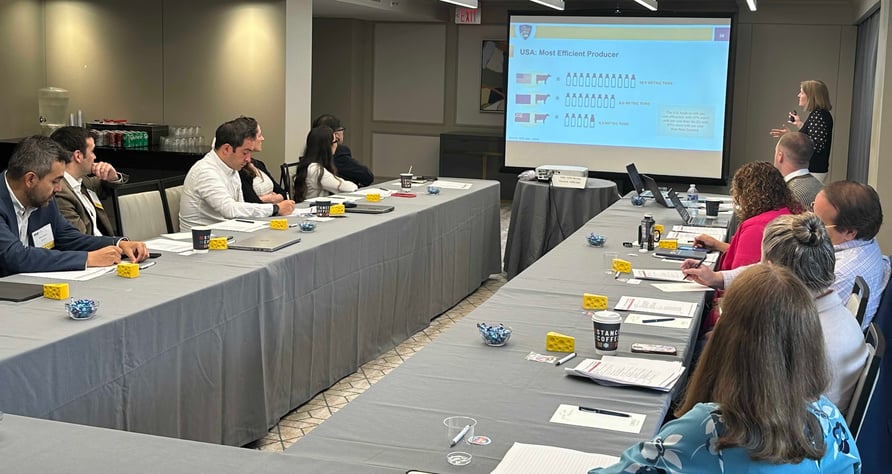
Angélique Hollister, USDEC Senior Vice President, Global Cheese Marketing (standing, front right), briefs the LatAm cheese buyer’s mission on U.S. dairy sustainability and the U.S. cheese industry.
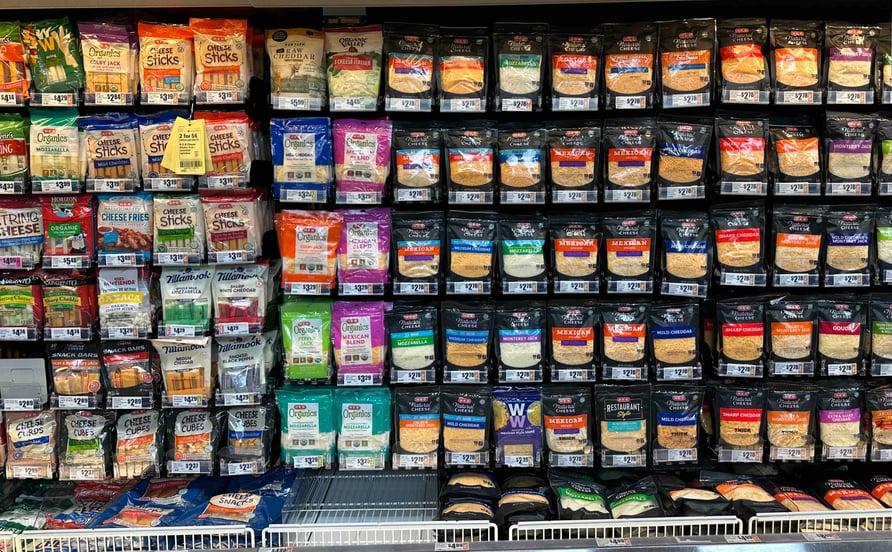
The LatAm cheese buyers got a first-hand view of the broad U.S. cheese portfolio during a tour of retail supermarkets in Houston.
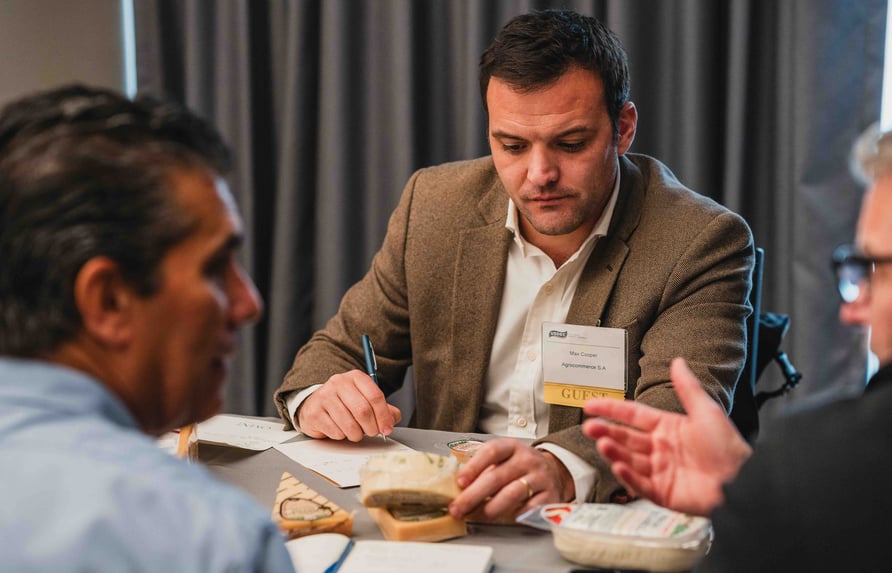
One of the LatAm cheese buyer’s mission participants, Max Cooper, head of cheese purchasing at Chilean food distributor Agrocommerce SA, talks U.S. Italian cheese at a one-on-one with USDEC member Tropical Foods.
USAID allocates additional $200 million to RUTF procurement and distribution
Samantha Power, administrator for the U.S. Agency for International Development (USAID) announced $200 million in additional funding “to maximize the procurement and distribution of ready-to-use therapeutic food (RUTF) and other specialized nutritious foods to prevent and treat acute malnutrition.”
The announcement follows a series of letters from agricultural groups and Congress last month seeking such additional food aid support (see Global Dairy eBrief, 4/5/24). USDEC and NMPF were co-signatories on the ag coalition letters and worked with congressional offices to shape its request.
RUTFs utilize a variety of U.S.-produced ingredients, including milk powder, peanuts, soybean oil/soy protein, sugar and a special vitamin mix. They are one of the most effective treatments for child malnutrition, particularly in addressing severe acute malnutrition, also known as “wasting,” which affects more than 45 million children globally. A similar investment in 2022, along with additional commitments from the Eleanor Cook Foundation and other private donors, resulted in a 35% increase in coverage of children suffering from wasting.
The money is especially needed now, given that food insecurity has been compounded by conflicts around the world and the impacts of the climate crisis.
As noted in one of the previous letters, not only do U.S. food aid programs benefit those in need, but they also serve U.S. economic and national security interests. By furthering stability in fragile countries and sparking hope, these kinds of foreign assistance programs help create a firm foundation for vulnerable communities to grow and prosper. Many former food aid recipient countries are now among the most important U.S. trading partners.
Sheridan represents U.S. dairy as progress is made on global plastics treaty
The fourth session of the “Intergovernmental Negotiating Committee to develop an International Legally Binding Instrument on Plastic Pollution, including in the Marine Environment” (INC-4) took place in Ottawa, Canada on April 23-29, 2024. It brought together over 2,500 participants, representing governments, academia, civil society, private sector, UN entities and international organizations. Kelly Sheridan, USDEC’s vice president, Environmental Affairs, was on the ground to represent U.S. dairy during the negotiations, which have the potential to impact food packaging policies in many key U.S. dairy export markets.
As a reminder, this is the fourth of five sessions scheduled following a resolution passed by the UN Environment Programme in 2022 calling for an international treaty to address plastics pollution. During INC-3, which was held in November 2023, negotiators produced a draft text that included multiple options and pathways forward. The most recent discussions in Ottawa were focused on narrowing those options and developing a plan for work to be accomplished between now and INC-5, which is scheduled for November 2024.
Sheridan has been closely engaging on issues that could potentially impact U.S. dairy production and exports, including a proposed “sectoral approach” focused on agriculture, and certain possible exemptions that may include food packaging or other products relevant to food security. Although progress was made at the meeting, both of these areas are still under negotiation and will not be tabled until resolution is reached on other elements of the text.
The key outcomes of INC-4 include:
- An agreement that a compilation of the work completed thus far will be the basis for the starting point at INC-5.
- The creation of two ad hoc intersessional open-ended expert groups. One will focus on the future implementation of the instrument, including financing mechanisms. The second will address plastic products and chemicals of concern in plastic products and design.
USDEC continues to work diligently with allied organization, the U.S. government and other stakeholders to share the positive efforts the U.S. dairy industry has taken to manage plastics waste and to share potential unintended consequences of certain policy approaches on plastics. If you would like to learn more about these global plastics issues or have examples of good practices or plastic initiatives your organization has developed, please contact Kelly Sheridan at ksheridan@usdec.org.
Market Summary
GDT bounces unexpectedly
The Global Dairy Trade (GDT) Price Index rose 1.8% at the May 7 auction—not a big increase unless you compare it to expectations heading into the event. For the second consecutive time, all pre-auction signals—SGX-NZX futures markets, GDT Pulse and analyst expectations—were well off the mark. Strong purchasing from Southeast Asia/Oceania and, to a lesser extent, the Middle East flipped the script, and anticipated declines for all major products turned into gains by the time trading ended.
Southeast Asia/Oceania played the key role in the increase. The region led all buyers, taking the most volume in SMP, WMP, butter and AMF. Southeast Asia increased both WMP and SMP purchasing versus the previous auction and the same auction last year. The Middle East increased WMP buying compared to the previous auction and the previous year and led all buyers for cheddar.
The downside to the auction continues to be China’s low profile. Chinese demand is still showing few signs that an import recovery is imminent. North Asia/China purchasing fell short of the previous year across all product categories and was down versus the previous auction for all categories except AMF.
While year-over-year Chinese milk production fell for the second straight month in March, domestic demand remains sluggish. Southeast Asia’s strong presence at this week’s auction is a positive sign, but further price gains may be challenging until Chinese dairy demand growth recovers.
Price changes
The biggest percentage increase came in cheddar, where the average winning price bounced back 8.0% to US$4,257/MT after declining 8.5% on April 16. The increase returns NZ cheddar to a premium over U.S. CME block prices but the price gap remains much smaller than U.S. suppliers enjoyed in the first quarter of the year.
Other price gains were more moderate. The average winning price for SMP increased only 0.4% to US$2,551/MT. It has been stable for the past three auctions. WMP increased 2.4% to US$3,350/MT, marking its the third straight gain. Prices rose across all contract periods for both products.
AMF rose 1.2% to a record high of US$7,124/MT. Butter grew 2.1% to US$6,593/MT and has been trading in a tight range for the past six auctions.
Supply Chain
USDEC testifies at USTR supply chain resilience hearing
USDEC Trade Policy Director Tony Rice testified before the USTR on ways in which trade policy can strengthen supply chain resiliency to ensure that the U.S. dairy industry continues to grow as a global leader. Echoing joint written comments USDEC and NMPF submitted to USTR in April (see Global Dairy eBrief, 4/26/24), Rice highlighted the need for a more proactive U.S. trade policy agenda that aggressively tackles global trade barriers and enhances market access to key partners.
Rice stressed how comprehensive trade deals align with the Biden Administration’s inclusive, worker-centered trade policy. He also recommended that USTR incorporate dairy-specific elements in trade negotiations, drawing on similar precedents set by annexes for wine in various agreement, or the broad recognition of the U.S. regulatory system for processed foods, including dairy, in the U.S.-Panama Trade Promotion Agreement.
Trade Policy
Letter urges Indonesia to protect common names
A group of eight U.S. food and ag organizations, including USDEC, NMPF and the Consortium for Common Foods Names (CCFN), sent a joint letter to Dr. Zulkifli Hassan, Indonesia’s Minister of Trade, urging vigilance as the country continues geographical indications (GI) discussions under the Indonesia-EU Comprehensive Economic Partnership Agreement (I-EU CEPA). The letter outlines the EU’s aggressive attempts globally to confiscate the rights of companies to use common food names by including lists of those names as protected GIs in trade agreements.
The letter contains categorized lists of food and beverage names, including 21 dairy terms, and asks Indonesia to preserve fair and unrestricted trading opportunities by maintaining them as common food names. It also notes that many of the names are individual components—or may sound like individual components—of multi-compound names that the EU is seeking to protect. In such cases, it asks Indonesia not to restrict them because of GI discussions under the I-EU CEPA.
The letter was copied to USDA Secretary Tom Vilsack and USTR Katherine Tai.
New Zealand launches trade talks with the UAE
New Zealand and the United Arab Emirates (UAE) officially launched negotiations toward a Comprehensive Economic Partnership Agreement (CEPA). New Zealand Minister of Trade Todd McClay, who was in the Middle East this week on a trade mission, called the UAE a “key export destination and hub in the Gulf region and said a CEPA would enhance cooperation in a range of areas, including agriculture.
McClay also said a deal with the UAE would “complement” a broader agreement with the Gulf Cooperation Council (GCC). New Zealand began negotiating with the GCC in 2007 but talks were put on hold in 2009 and only restarted two years ago. (New Zealand Herald, 5/6/24)
New Zealand says it will continue to fight Canadian TRQ allocation scheme
New Zealand said it had no intention of backing down in its trade dispute with Canada over Canada’s tariff rate quota (TRQ) allocation system for dairy. New Zealand challenged that TRQ scheme under the Comprehensive and Progressive Agreement for Trans-Pacific Partnership (CPTPP), and a dispute settlement panel ruled in its favor.
Late last week, Canada published new TRQ system guidelines that Kiwi Trade Minister Todd McClay said still failed to comply with the ruling—much like Canada did for the original U.S. challenge to its TRQ system under the U.S.-Mexico-Canada Agreement.
McClay said the country was exploring its legal options and would “defend hard-won free trade agreement commitments.” (Radio New Zealand, 5/2/24)
Company News
Mars announces new dairy sustainability program
Chicago-based Mars Inc. announced the launch of a sustainable dairy plan as part of its efforts to cut greenhouse gas (GHG) emissions by 50% by 2030. As part of the plan, which commits $47 million over three years, Mars will work with a cohort of industry partners to implement on-farm interventions focused on areas including enteric methane reduction, efficient manure management and sustainable feed production. It includes a collaboration with Netherlands-based dairy cooperative FrieslandCampina for a program that will dedicate a group of farms to Mars' dairy supply and serve as a platform where new practices and innovations can be refined and scaled-up, with an ultimate goal of broader adoption across the entire co-op. (Company reports)
Dale Farm investing in cheddar production
U.K.-based dairy cooperative Dale Farm said it is investing £70 million (about US$75 million) in its Dunmanbridge, Northern Ireland, cheddar processing facility. The expansion will include enhanced technologies and equipment that the company says will boost production by 20,000 MT per year to meet growing customer demand across the UK, Europe and beyond. The expanded operations are expected to begin in February 2025. (Company reports)
Chinese corporate report roundup
Some major Chinese dairy processors struggled amid slow growth in 2023, a year marked by a continuing low birth rate and other challenges in the sector. Even processors based in nearby markets but serving China cited difficult Chinese market conditions for their own struggles.
In Japan, Meiji Holdings cut its forecast profit due to impairment charges that the dairy company said it is incurring “on non-current assets related to the drinking milk and yogurt business operated by subsidiaries in China.” In a company filing with the Tokyo Stock Exchange, Meiji said, “the sales environment for the drinking milk and yogurt business in China has been significantly changed. The price competition in the market intensified, leading to a decline in our profitability.”
- Shanghai Milkground Food Tech net profit dropped nearly 54% in 2023 while revenues fell 16% from the previous year. The company said the rising cost of raw materials resulted in a year-on-year decline in the gross profit margin of the company's cheese segment. In 2023, the cheese segment accounted for nearly 99% of the company’s total gross profit, up 3% compared to the previous year. Revenue dropped from ready-to-consume nutrition products (such as lollipop-shaped cheese) and “cooking cheese” (such as cheese slices). In the future, the company plans to diversify the consumption scenarios of cheese products. The company has seen some slight improvements in the first quarter of 2024, with down only 7% YOY and net profit up 71%.
- Mengniu Dairy’s profits dropped 9% YOY to US$664 million in 2023, a decline the company attributed to higher tax expenditures and reduced earnings. Revenue lifted 6.5% YOY to US$13.6 billion. The company said its core fluid milk business experienced continuous growth, driven in part by market share gains made by its flagship “Milk Deluxe” product. It also noted its global expansion, including the growth of its ice cream business in Southeast Asia, where it says its Aice brand reached the top market share position in Indonesia while also entering Thailand, Vietnam, Cambodia and Laos.
- In its FY 2023 report, China Feihe said group revenue declined 8% and group profit dropped 33% from the previous year. The Chinese organization blamed China’s low birth rate and competitiveness in the dairy industry for the decreases. Feihe’s infant milk formula business, which comprises more than 90% of its entire business, saw revenues drop 10%. But its other dairy products, including liquid milk and adult milk powder, saw revenue climb 23%. Looking ahead, Feihe Chairman Leng Youbin believes the infant formula milk market in China will remain stable and be driven by premium products in 2024. (USDEC China office; Company reports; Just Food, 4/9/24; Food Navigator Asia; 4/9/24 Yicai Global, 3/27/24)
Tirlán profits dip during “extremely challenging” year
Irish dairy co-operative Tirlán reported 2023 results the company characterized as “reflecting a resilient performance during an extremely challenging year for the Irish dairy, grain and wider agriculture sector.” Turnover fell 17% from the previous year, a drop the company attributed to lower commodity market prices. Profits fell 5%, with the company citing factors including inflationary pressures and its commitment to supporting farmers through a difficult year.
The company said Tirlán’s dairy business continued to grow new markets, noting in particular the expansion of its Avonmore brand Professional UHT range in China and Vietnam, and entering the new markets of Malaysia, Thailand and the Philippines in Southeast Asia. Looking forward, the company said it will continue to focus on adding value to its portfolio through ongoing product innovation to grow international markets. (Company reports)
FrieslandCampina tweaks overseas operations
Netherlands-based FrieslandCampina moved its UK headquarters and opened a new technology center in Malaysia as part of a push to upgrade its overseas operations. A desire to create a “more modern and dynamic” workspace ahead of expanding in the U.K. and Ireland led the company to relocate its U.K. headquarters from West Sussex to London.
In Malaysia, the company’s new Technology Excellence Centre will focus on expanding global IT initiatives to impact the future operations of FrieslandCampina’s seven business groups. Operations at the center, which is located at FrieslandCampina subsidiary Dutch Lady Milk Industries, include data and analytics, cloud and platform engineering services, and IT service management. (Food Manufacture, 4/30/24; Company reports)
Mergers, acquisitions and joint ventures
As part of its efforts to strengthen its Medical Nutrition portfolio in the U.S., French dairy giant Danone completed the acquisition of Functional Formularies, an Ohio-based whole foods tube feeding business. A Danone official said the deal will make the company “even better positioned to support the nutritional needs of tube-fed families and patients.” (Company report)
In Case You Missed It...
U.S. Dairy Exporter Blog
Market analysis, research and news subscribe hereUSDEC Twitter feed
Follow us here.